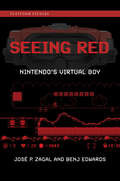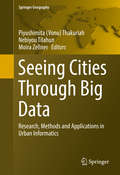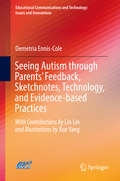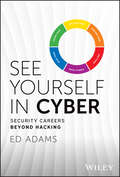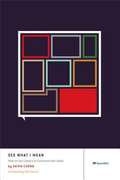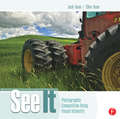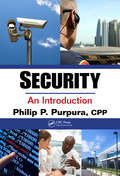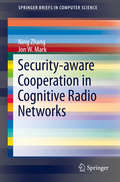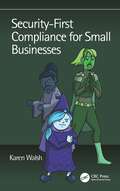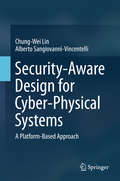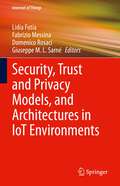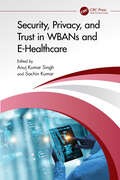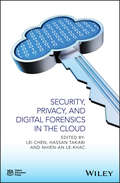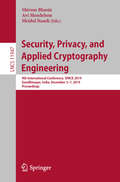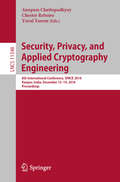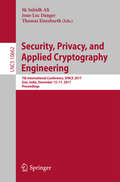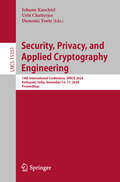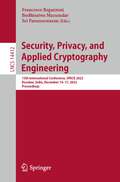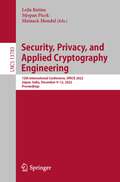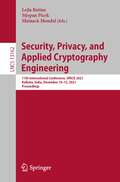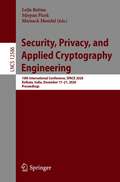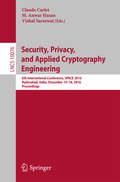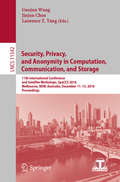- Table View
- List View
Seeing Red: Nintendo's Virtual Boy (Platform Studies)
by Jose P. Zagal Benj EdwardsThe curious history, technology, and technocultural context of Nintendo&’s short-lived stereoscopic gaming console, the Virtual Boy.With glowing red stereoscopic 3D graphics, the Virtual Boy cast a prophetic hue: Shortly after its release in 1995, Nintendo's balance sheet for the product was "in the red" as well. Of all the innovative long shots the game industry has witnessed over the years, perhaps the most infamous and least understood was the Virtual Boy. Why the Virtual Boy failed, and where it succeeded, are questions that video game experts José Zagal and Benj Edwards explore in Seeing Red, but even more interesting to the authors is what the platform actually was: what it promised, how it worked, and where it fit into the story of gaming.Nintendo released the Virtual Boy as a standalone table-top device in 1995—and quickly discontinued it after lackluster sales and a lukewarm critical reception. In Seeing Red, Zagal and Edwards examine the device's technical capabilities, its games, and the cultural context in the US in the 1990s when Nintendo developed and released the unusual console. The Virtual Boy, in their account, built upon and extended an often-forgotten historical tradition of immersive layered dioramas going back 100 years that was largely unexplored in video games at the time. The authors also show how the platform's library of games conveyed a distinct visual aesthetic style that has not been significantly explored since the Virtual Boy's release, having been superseded by polygonal 3D graphics. The platform's meaning, they contend, lies as much in its design and technical capabilities and affordances as it does in an audience's perception of those capabilities. Offering rare insight into how we think about video game platforms, Seeing Red illustrates where perception and context come, quite literally, into play.
Seeing Cities Through Big Data
by Piyushimita Vonu Thakuriah Nebiyou Tilahun Moira ZellnerThis book introduces the latest thinking on the use of Big Data in the context of urban systems, including research and insights on human behavior, urban dynamics, resource use, sustainability and spatial disparities, where it promises improved planning, management and governance in the urban sectors (e. g. , transportation, energy, smart cities, crime, housing, urban and regional economies, public health, public engagement, urban governance and political systems), as well as Big Data's utility in decision-making, and development of indicators to monitor economic and social activity, and for urban sustainability, transparency, livability, social inclusion, place-making, accessibility and resilience.
Seeing Autism through Parents’ Feedback, Sketchnotes, Technology, and Evidence-based Practices (Educational Communications and Technology: Issues and Innovations)
by Demetria Ennis-ColeSeeing Autism is a comprehensive but easy-to-understand guidebook for caretakers, parents, educators, counselors, therapists, and researchers on various aspects of rearing and supporting children with autism spectrum disorder. It provides textual and visual information on technology tools, symptoms, diagnosis, auditory, sensory, visual, physical, and educational issues, as well as strategies and practices to help children on the Autism Spectrum reach their potential. Seeing Autism uniquely capitalizes on sketchnotes, a visual thinking tool, to communicate information and practices. Sketchnotes provide a unique space that can help the reader think differently, generate a variety of ideas, explore alternatives, and develop constructive points for expressing ideas and developing visual communication aids. This book will assist parents, educators, and professionals in schools (counselors, school psychologists, librarians) who work with children diagnosed with ASD; it will help readers increase their knowledge of autism and gain an appreciation for evidence-based practices and forms of technology that can be used to support learners on the autism spectrum. “This book is a call to arms and is as much a resource for the family friend as it is for the provider coming to the home. In the book Seeing Autism, Dr. Demetria Ennis-Cole helps individuals gain an incredible perspective and learn the struggles, challenges and joys of families rearing children, teens and adults on the spectrum. This book covers the entire spectrum and is a fantastic mix of research, parent perspective, and even sketchnotes for visual learners. The material is well-balanced and is a great resource to support individuals on the spectrum at home, in the community or in the classroom." Brad McGarryFather, Speaker, Author and Director of the Autism Initiative at Mercyhurst University
See Yourself in Cyber: Security Careers Beyond Hacking
by Ed AdamsA one-of-a-kind discussion of how to integrate cybersecurity into every facet of your organization In See Yourself in Cyber: Security Careers Beyond Hacking, information security strategist and educator Ed Adams delivers a unique and insightful discussion of the many different ways the people in your organization—inhabiting a variety of roles not traditionally associated with cybersecurity—can contribute to improving its cybersecurity backbone. You’ll discover how developers, DevOps professionals, managers, and others can strengthen your cybersecurity. You’ll also find out how improving your firm’s diversity and inclusion can have dramatically positive effects on your team’s talent. Using the familiar analogy of the color wheel, the author explains the modern roles and responsibilities of practitioners who operate within each “slice.” He also includes: Real-world examples and case studies that demonstrate the application of the ideas discussed in the book Many interviews with established industry leaders in a variety of disciplines explaining what non-security professionals can do to improve cybersecurity Actionable strategies and specific methodologies for professionals working in several different fields interested in meeting their cybersecurity obligationsPerfect for managers, directors, executives, and other business leaders, See Yourself in Cyber: Security Careers Beyond Hacking is also an ideal resource for policymakers, regulators, and compliance professionals.
See Ya Later: The World According to Arron Crascall
by Arron CrascallAlright guys? It's me, Arron. Or as some people call me, 'that guy with the phone, the skinny jeans and the really fat head'.In a world that seems to be freefalling without a parachute towards utter chaos, I'm here to remind you that when life gives you lemons, make lemonade. No, in fact, when life gives you lemons, make a fool out of yourself in the lemonade aisle.*Because there's more to life than Brexit, Bake Off and banging on about being vegan. Yes, with this book - which is my take on the world - you will learn how to survive a proper lads' holiday, become a master in the art of takeaway ordering and find out about the pitfalls of seriously inappropriate tattoos.So do yourself a favour: turn off the news, cancel that juice cleanse, open your eyes to the brilliant, hilarious world we live in and most importantly . . . buy this book.SEE YA LATER! Arron x*Actually, don't do exactly that, that's my thing.
See What I Mean
by Kevin ChengIf you're an executive, designer, product manager, marketer, or engineer, communication is part of your work. Using images and text in unique ways, comics can engage readers in ways traditional methods can't. In See What I Mean, you'll learn how to create comics about your products and processes without an illustrator—just like Google, eBay, and Adobe do.
See It: Photographic Composition Using Visual Intensity
by Josh Anon Ellen AnonA good image is more than just acceptable exposure and sharp focus -- two components that photography instruction concentrates on. A fascinating subject doesn't necessarily result in a good image, and likewise, it's possible to create an outstanding image of a mundane subject. So how do you know the difference? Perhaps you've read a lot of material on how to use your camera, how to manage images, and/or how to make adjustments using different software programs. What usually is not covered is what needs to be done beyond obvious exposure, noise, and sharpening issues so that you can intuitively recognize the difference between a good and bad image, and most importantly, why. That's where this book comes in. Rather than wasting time blindly trying one approach or another until something seems right, the quality of your imagery and the speed of your workflow will both vastly improve once you are able to articulate why you prefer one image to another. Expert authors Josh and Ellen Anon have spent years perfecting their visual-intensity based approach to composition, and in this gorgeous, full color guide, they'll share their techniques with you so that your overall photographic experience, both in terms of time investment and quality of output, will become a much more satisfying one.
Seduce Me: A Stark Ever After Novella (Stark Series #18)
by J. KennerNew York Times bestselling author J. Kenner continues her beloved Stark series with a scorching-hot Stark Ever After novella for Nikki and Damien Stark as they make an impromptu getaway to Las Vegas. For fans of Fifty Shades of Grey, Sylvia Day, Meredith Wild and Jodi Ellen Malpas. There's no better place to turn up the heat than in Sin City...I've never felt as close to anyone as I have with Damien Stark. I know every line of his body, every secret within his soul. There's nothing I crave more than his touch, and with his kiss, he seals his claim.Las Vegas is the perfect place for us, where we can indulge every desire and fantasy. But when someone from my past resurfaces, I can't ignore my instinct that I have to make things right.With Damien by my side, I feel safe no matter the danger. Our passion protects us, drives us, makes us whole. His pleasure is an exquisite game, and one that I'll play forever.Find out how it all began for Damien and Nikki in J. Kenner's hot and addictive bestselling Stark series: Release Me, Claim Me, Complete Me, Take Me, Have Me and Play My Game.Return to the smoking hot Stark world with the Stark International trilogy: Say My Name, On My Knees and Under My Skin is the explosively emotional story of Jackson Steele and Sylvia Brooks.Don't miss J. Kenner's sizzling Most Wanted series of three enigmatic and powerful men, and the striking women who can bring them to their knees: Wanted, Heated and Ignited.***SEDUCE ME was previously published for a limited time in the SWEET SEDUCTION anthology***
Security: An Introduction
by Philip P. PurpuraToday, threats to the security of an organization can come from a variety of sources- from outside espionage to disgruntled employees and internet risks to utility failure. Reflecting the diverse and specialized nature of the security industry, Security: An Introduction provides an up-to-date treatment of a topic that has become increasingly comple
Security-aware Cooperation in Cognitive Radio Networks
by Ning Zhang Jon W. MarkThis brief investigates spectrum efficient and energy efficient strategies, known as cognitive radio networks (CRNs), to ensure secure cooperation between licensed and unlicensed users. The authors address issues of spectrum scarcity, spectrum sensing, transmission performance, trust-aware cooperation, and secure communications. Two security-aware cooperation based spectrum access schemes are presented. The first is a trust-aware cooperative framework for CRNs to improve the throughput or energy efficiency of licensed users and offer transmission opportunities to unlicensed users, taking into consideration the trustworthiness of unlicensed users. The second scheme is a cooperative framework to enhance secure communications of licensed users. An introduction to CRNs and literature survey enhance the discussion while numerical results are provided to demonstrate the viability of the proposed schemes. The brief is designed for researchers and professionals working with cognitive radio networks or interested in cooperation based access. Advanced-level students studying computer communication networks and communications engineering will also find this brief useful.
Security-First Compliance for Small Businesses
by Karen WalshOrganizations of all sizes struggle to secure their data in a constantly evolving digital landscape. Expanding digital footprints and the rapid expansion of cloud strategies arising from the COVID-19 pandemic increase an organization’s attack surface. When combined with limited resources caused by the cybersecurity skills gap, securing small and mid-sized business IT infrastructures becomes more complicated. With limited staffing and budgetary restrictions, small businesses need to create cost-effective, security-driven programs that protect data while also meeting increasingly stringent compliance requirements. This book bridges the gap between complex technical language and business objectives to create a security-first review of the security and compliance landscapes. Starting from the premise that “with security comes compliance,” this book starts by defining “security-first” and then walking readers through the process of creating a holistic security and compliance program. Looking at security and privacy through the lens of zero trust, this overview of regulations and industry standards provides both background about and implications drawn from modern security practices. Rather than focusing solely on individual cybersecurity frameworks, this book offers insights into best practices based on the commonalities between regulations and industry standards, highlighting some of the primary differences to show the nuances. Woven throughout are practical examples of solutions that enable small and mid-sized businesses to create “cybersustainable” security-focused policies, processes, and controls that protect today’s future for tomorrow’s digital ecosystem.
Security-Aware Design for Cyber-Physical Systems
by Alberto Sangiovanni-Vincentelli Chung-Wei LinAddressing the rising security issues during the design stages of cyber-physical systems, this book develops a systematic approach to address security at early design stages together with all other design constraints. Cyber-attacks become more threatening as systems are becoming more connected with the surrounding environment, infrastructures, and other systems. Security mechanisms can be designed to protect against attacks and meet security requirements, but there are many challenges of applying security mechanisms to cyber-physical systems including open environments, limited resources, strict timing requirements, and large number of devices. Designed for researchers and professionals, this book is valuable for individuals working in network systems, security mechanisms, and system design. It is also suitable for advanced-level students of computer science.
Security, Trust and Privacy Models, and Architectures in IoT Environments (Internet of Things)
by Domenico Rosaci Giuseppe M. L. Sarné Lidia Fotia Fabrizio MessinaThis book is dedicated to the issues of security, trust and privacy models, and architectures in IoT environments. The authors aim to capture the latest research and contributions from academy, industry, and other stakeholders on new security models, architectures, protocols, and standards for ensuring security, privacy, and trustworthiness to IoT systems. The authors discuss the convergence of IoT, software agents, and edge computing to introduce social features into IoT systems, combining trustworthiness and reputation information collected by agents at the edge with security and privacy mechanisms. They also cover experimental and simulated campaigns that evaluate strategies to improve the security and privacy of the IoT world, and at the same time the ability to prevent and deter deceptive behaviors. The book is relevant for researchers, professionals, academics, and students.
Security, Privacy, and Trust in WBANs and E-Healthcare
by Sachin Kumar Anuj Kumar SinghWireless Body Area Networks (WBANs) are vulnerable to cyberattacks and security breaches that could unlock the door for cybercriminals to penetrate hospital networks. This book covers the fundamental concepts of security and privacy in WBANs including security requirements, issues, and challenges.Security, Privacy, and Trust in WBANs and E-Healthcare highlights the taxonomy of threats and attacks in WBANs and Internet of Medical Things (IoMT) and presents all technical aspects related to the security and privacy of WBANs. In addition to outlining viable solutions that take into account constrained resources at WBAN end-devices, hybrid network architecture, application characteristics, and communication protocols, the book covers the core concepts of WBAN security, privacy, and trust. It describes both theoretical and practical aspects for those working in security in the WBAN and IoMT, emphasizing the most significant potential WBAN security issues and challenges. The book also covers intrusion detection and security risk assessments in WBANs as well as lightweight security solutions for WBANs, blockchain-based solutions for WBANs, and authentication and access control in WBANs through various applications and case studies.This book is highly relevant to the graduate/postgraduate students, academicians, security system designers, security analysts, computer scientists, engineers, researchers, digital forensic experts, and other personnel working in information security, IoMT, and WBAN.
Security, Privacy, and Digital Forensics in the Cloud
by Lei Chen Hassan Takabi Nhien-An Le-KhacIn a unique and systematic way, this book discusses the security and privacy aspects of the cloud, and the relevant cloud forensics. Cloud computing is an emerging yet revolutionary technology that has been changing the way people live and work. However, with the continuous growth of cloud computing and related services, security and privacy has become a critical issue. Written by some of the top experts in the field, this book specifically discusses security and privacy of the cloud, as well as the digital forensics of cloud data, applications, and services. The first half of the book enables readers to have a comprehensive understanding and background of cloud security, which will help them through the digital investigation guidance and recommendations found in the second half of the book. Part One of Security, Privacy and Digital Forensics in the Cloud covers cloud infrastructure security; confidentiality of data; access control in cloud IaaS; cloud security and privacy management; hacking and countermeasures; risk management and disaster recovery; auditing and compliance; and security as a service (SaaS). Part Two addresses cloud forensics – model, challenges, and approaches; cyberterrorism in the cloud; digital forensic process and model in the cloud; data acquisition; digital evidence management, presentation, and court preparation; analysis of digital evidence; and forensics as a service (FaaS). Thoroughly covers both security and privacy of cloud and digital forensics Contributions by top researchers from the U.S., the European and other countries, and professionals active in the field of information and network security, digital and computer forensics, and cloud and big data Of interest to those focused upon security and implementation, and incident management Logical, well-structured, and organized to facilitate comprehension Security, Privacy and Digital Forensics in the Cloud is an ideal book for advanced undergraduate and master's-level students in information systems, information technology, computer and network forensics, as well as computer science. It can also serve as a good reference book for security professionals, digital forensics practitioners and cloud service providers.
Security, Privacy, and Applied Cryptography Engineering: 9th International Conference, SPACE 2019, Gandhinagar, India, December 3–7, 2019, Proceedings (Lecture Notes in Computer Science #11947)
by Avi Mendelson Shivam Bhasin Mridul NandiThis book constitutes the refereed proceedings of the 9th International Conference on Security, Privacy, and Applied Cryptography Engineering, SPACE 2019, held in Gandhinagar, India, in December 2019. The 12 full papers presented were carefully reviewed and selected from 24 submissions. This annual event is devoted to various aspects of security, privacy, applied cryptography, and cryptographic engineering. This is a very challenging field, requiring the expertise from diverse domains, ranging from mathematics to solid-state circuit design.
Security, Privacy, and Applied Cryptography Engineering: 8th International Conference, SPACE 2018, Kanpur, India, December 15-19, 2018, Proceedings (Lecture Notes in Computer Science #11348)
by Chester Rebeiro Anupam Chattopadhyay Yuval YaromThis book constitutes the refereed proceedings of the 8th International Conference on Security, Privacy, and Applied Cryptography Engineering, SPACE 2018, held in Kanpur, India, in December 2018. The 12 full papers presented together with 5 short paper, were carefully reviewed and selected from 34 submissions. This annual event is devoted to various aspects of security, privacy, applied cryptography, and cryptographic engineering. This is indeed a very challenging field, requiring the expertise from diverse domains, ranging from mathematics to solid-state circuit design.
Security, Privacy, and Applied Cryptography Engineering: 7th International Conference, SPACE 2017, Goa, India, December 13-17, 2017, Proceedings (Lecture Notes in Computer Science #10662)
by Sk Subidh Ali, Jean-Luc Danger and Thomas EisenbarthThis book constitutes the refereed proceedings of the 7th International Conference on Security, Privacy, and Applied Cryptography Engineering, SPACE 2017, held in Goa, India, in December 2017. The 13 revised full papers presented together with 1 short paper, 7 invited talks, and 4 tutorials were carefully reviewed and selected from 49 initial submissions. This annual event is devoted to various aspects of security, privacy, applied cryptography, and cryptographic engineering. This is indeed a very challenging field, requiring the expertise from diverse domains, ranging from mathematics to solid-state circuit design.
Security, Privacy, and Applied Cryptography Engineering: 14th International Conference, SPACE 2024, Kottayam, India, December 14–17, 2024, Proceedings (Lecture Notes in Computer Science #15351)
by Domenic Forte Johann Knechtel Urbi ChatterjeeThis book constitutes the refereed proceedings of the 14th International Conference on Security, Privacy, and Applied Cryptography Engineering, SPACE 2024, held in Kottayam, India, during December 14–17, 2024. The 8 full papers, 10 short papers and 1 invited paper included in this book were carefully reviewed and selected from 43 submissions. They were organized in topical sections as follows: security, privacy, applied cryptographic engineering, integration of machine learning techniques, reflecting the growing prominence of this approach in contemporary research on security and cryptography, hardware security, the exploration of post-quantum cryptography, and the development of efficient implementations for emerging cryptographic primitives.
Security, Privacy, and Applied Cryptography Engineering: 13th International Conference, SPACE 2023, Roorkee, India, December 14–17, 2023, Proceedings (Lecture Notes in Computer Science #14412)
by Sri Parameswaran Francesco Regazzoni Bodhisatwa MazumdarThis book constitutes the refereed proceedings of the 13th International Conference on Security, Privacy, and Applied Cryptography Engineering, SPACE 2023, held in Roorkee, India, in December 2023.The 14 papers included in these proceedings were carefully reviewed and selected from 45 submissions. They focus on various aspects of security, privacy, applied cryptography, and cryptographic engineering.
Security, Privacy, and Applied Cryptography Engineering: 12th International Conference, SPACE 2022, Jaipur, India, December 9–12, 2022, Proceedings (Lecture Notes in Computer Science #13783)
by Lejla Batina Stjepan Picek Mainack MondalThis book constitutes the refereed proceedings of the 12th International Conference on Security, Privacy, and Applied Cryptography Engineering, SPACE 2022 held in Jaipur, India, during December 9–12, 2022.The 18 full papers included in this book were carefully reviewed and selected from 61 submissions. They were organized in topical sections as follows: symmetric cryptography; public-key cryptography, post-quantum cryptography, zero knowledge proofs; hardware security and AI; and network security, authentication, and privacy.
Security, Privacy, and Applied Cryptography Engineering: 11th International Conference, SPACE 2021, Kolkata, India, December 10–13, 2021, Proceedings (Lecture Notes in Computer Science #13162)
by Lejla Batina Stjepan Picek Mainack MondalThis book constitutes the refereed proceedings of the 11th International Conference on Security, Privacy, and Applied Cryptography Engineering, SPACE 2021, held in Kolkata, India, in December 2021. The 13 full papers presented were carefully reviewed and selected from 42 submissions. This annual event is devoted to various aspects of security, privacy, applied cryptography, and cryptographic engineering. This is a very challenging field, requiring the expertise from diverse domains, ranging from mathematics to solid-state circuit design.
Security, Privacy, and Applied Cryptography Engineering: 10th International Conference, SPACE 2020, Kolkata, India, December 17–21, 2020, Proceedings (Lecture Notes in Computer Science #12586)
by Lejla Batina Stjepan Picek Mainack MondalThis book constitutes the refereed proceedings of the 10th International Conference on Security, Privacy, and Applied Cryptography Engineering, SPACE 2020, held in Kolkata, India, in December 2020. Due to COVID-19 pandemic, the conference was held virtual. The 13 full papers presented were carefully reviewed and selected from 48submissions. This annual event is devoted to various aspects of security, privacy, applied cryptography, and cryptographic engineering. This is a very challenging field, requiring the expertise from diverse domains, ranging from mathematics to solid-state circuit design.
Security, Privacy, and Applied Cryptography Engineering
by Claude Carlet M. Anwar Hasan Vishal SaraswatThis book constitutes the refereed proceedings of the 6th International Conference on Security, Privacy, and Applied Cryptography Engineering, SPACE 2016, held in Hyderabad, India, in December 2016. This annual event is devoted to various aspects of security, privacy, applied cryptography, and cryptographic engineering. This is indeed a very challenging field, requiring the expertise from diverse domains, ranging from mathematics to solid-state circuit design.
Security, Privacy, and Anonymity in Computation, Communication, and Storage: Spaccs 2017 International Workshops, Guangzhou, China, December 12-15, 2017, Proceedings (Lecture Notes in Computer Science #10658)
by Jinjun Chen Laurence T. Yang Guojun WangThis book constitutes the refereed proceedings of the 11th International Conference on Security, Privacy, and Anonymity in Computation, Communication, and Storage. The 45 revised full papers were carefully reviewed and selected from 120 submissions. The papers cover many dimensions including security algorithms and architectures, privacy-aware policies, regulations and techniques, anonymous computation and communication, encompassing fundamental theoretical approaches, practical experimental projects, and commercial application systems for computation, communication and storage.
